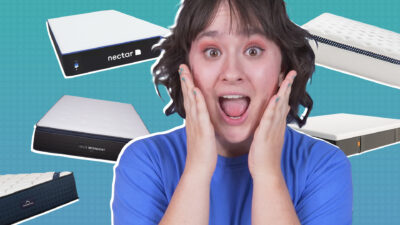Buying the best mattress for couples can be quite the task. Not only are you looking for a mattress that is going to be best for your sleeping position, pain relief, and weight, but you also want to find one that fits with your partner’s needs as well. For the majority of couples, the main factors in buying a mattress for two are going to be edge support, motion isolation, ability to move on top of the mattress, and cooling technology.
Here at Sleepopolis, we test all of these factors and more before recommending any mattress to couples. If your main goal is spreading out on the mattress, find one with great edge support below. What if you’re worried about feeling your partner tossing and turning throughout the night? We highlight the mattresses with the best motion transfer so your sleep won’t be interrupted by your restless partner. Many of the mattresses on this list also include some sort of cooling technology, which is important for hot sleepers who don’t want the added body heat in their bed to get in the way of a good night’s rest. Our firmer mattresses are better for sex, since couples will be able to move around more easily on top of them.
No matter what your deal-breaker is when sleeping with a partner, Sleepopolis has the mattress to fit your specific needs. Read more below to find which mattress is perfect for both of you.
Our Top Pick for Couples
The Helix Dusk Luxe leads the way on this list since it’s not only supportive and cooling, but also comfortable for multiple sleeping positions, easy to move around on, and has good edge support (so you won’t feel like you’re about to fall off the side of the bed).
Best Mattresses for Couples
- Helix Dusk Luxe – Best Overall Mattress for Couples
- Emma Hybrid Comfort – Best Hybrid Mattress for Couples
- Saatva – Best Mattress for Sex
- WinkBed Plus – Best Mattress for Heavy Couples
- Nolah – Best Mattress for Side-Sleeping Couples
- Leesa Sapira Chill – Best Mattress for Back-Sleeping Couples
- Brooklyn Bedding Sedona – Best Pressure-Relieving Mattress for Couples
- Titan Plus – Best Mattress for Stomach-Sleeping Couples
- Loom & Leaf – Best Luxury Mattress for Couples
- Birch Luxe – Best Cooling Mattress for Couples
Best Mattress for Couples Video
Compare Best Mattresses For Couples
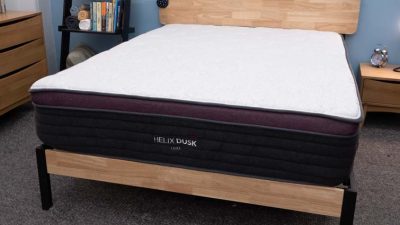
|
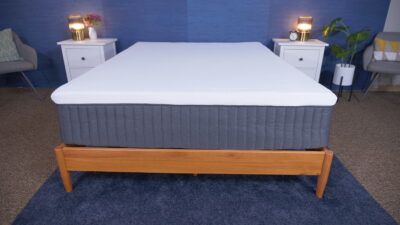
|
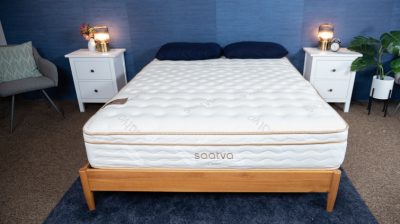
|
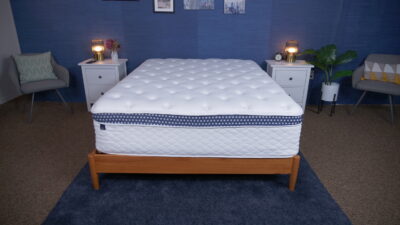
|
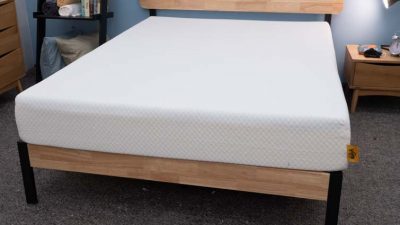
|
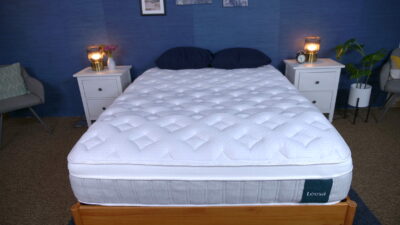
|
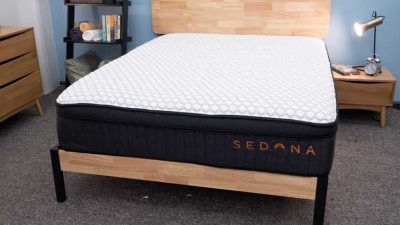
|
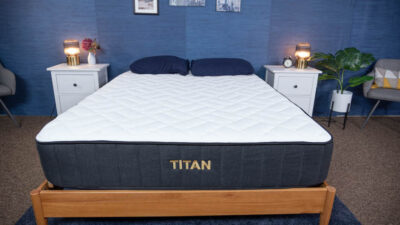
|
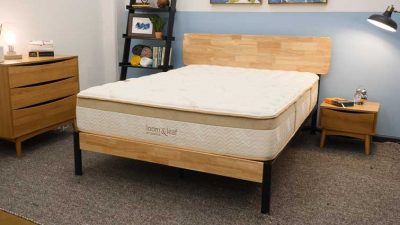
|
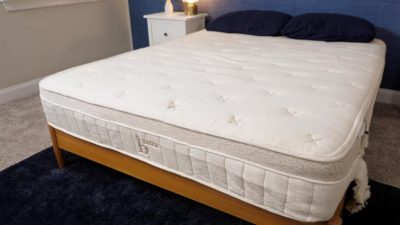
|
|
| Helix Dusk Luxe Mattress | Emma Hybrid Comfort | Saatva Mattress | WinkBed Plus Mattress | Nolah Original 10" Mattress | Leesa Sapira Chill Hybrid | Brooklyn Bedding Sedona Elite Mattress | Titan Plus | Loom & Leaf Mattress | Birch Luxe Natural Mattress | |
| Rating | ||||||||||
| Firmness | Medium-firm: 6.5/10 | Firm: 7.5/10 | Multiple firmness options | Firm: 7.5/10 | Medium-firm: 6.5/10 | Multiple firmness options | Soft: 5/10 | Firm: 7.5/10 | Multiple firmness options | Firm: 7/10 |
| Material | Hybrid | Hybrid | Innerspring | Hybrid | Foam | Hybrid | Hybrid | Hybrid | Foam | Hybrid |
| Cooling | ✓ | ✓ | ✓ | ✓ | -- | -- | ✓ | -- | -- | -- |
| Sleep Position | Combination | Back & Stomach | Back & Stomach | Back & Stomach | Back & Side | Combination | Side | Back & Stomach | Back & Side | Back & Stomach |
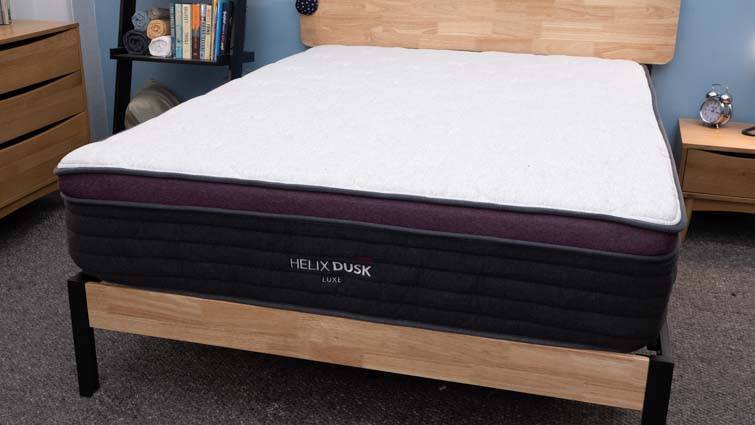
|
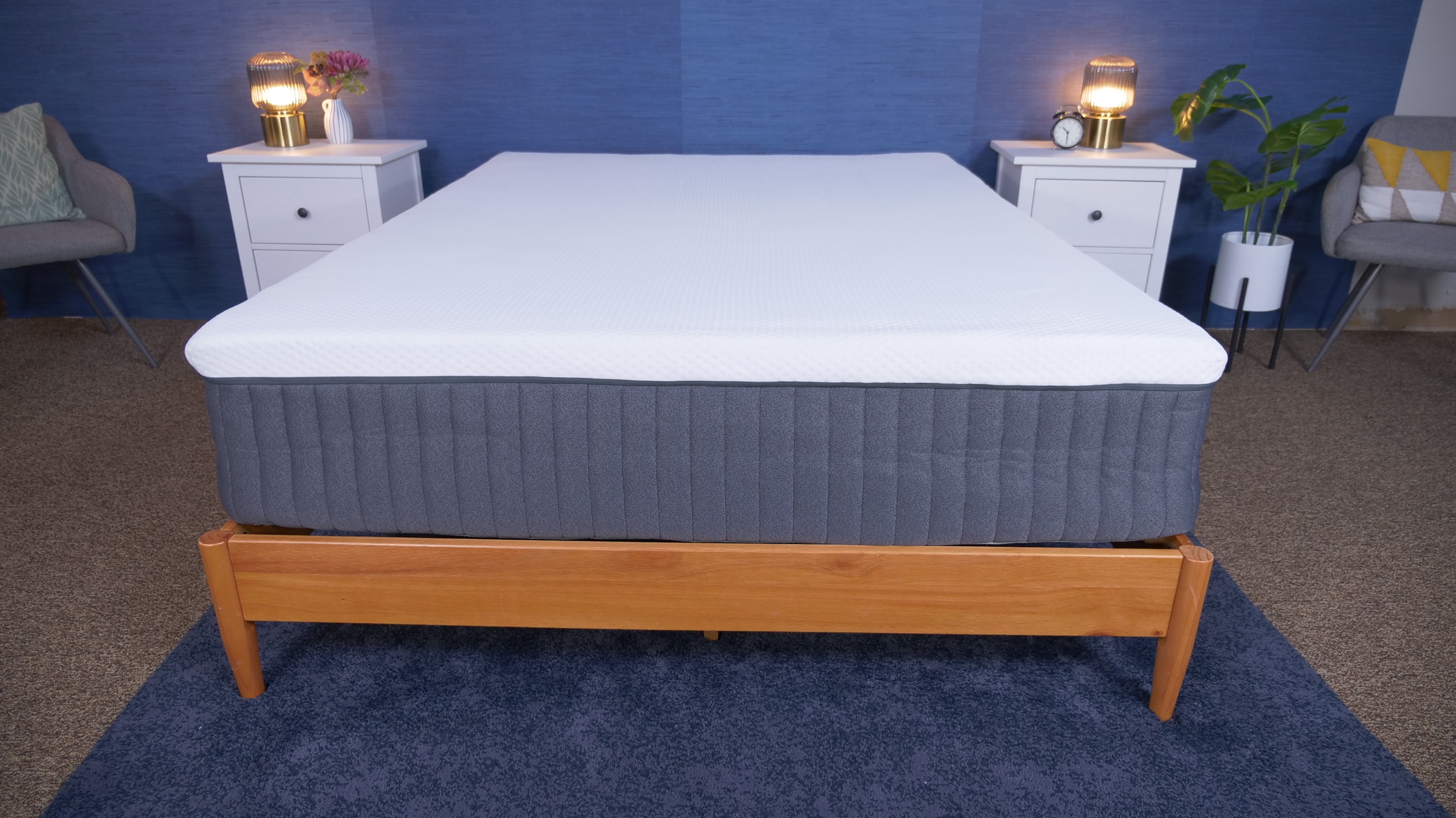
|
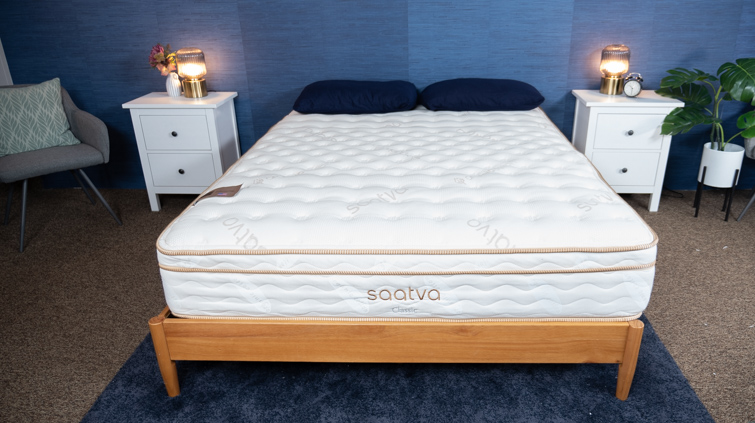
|
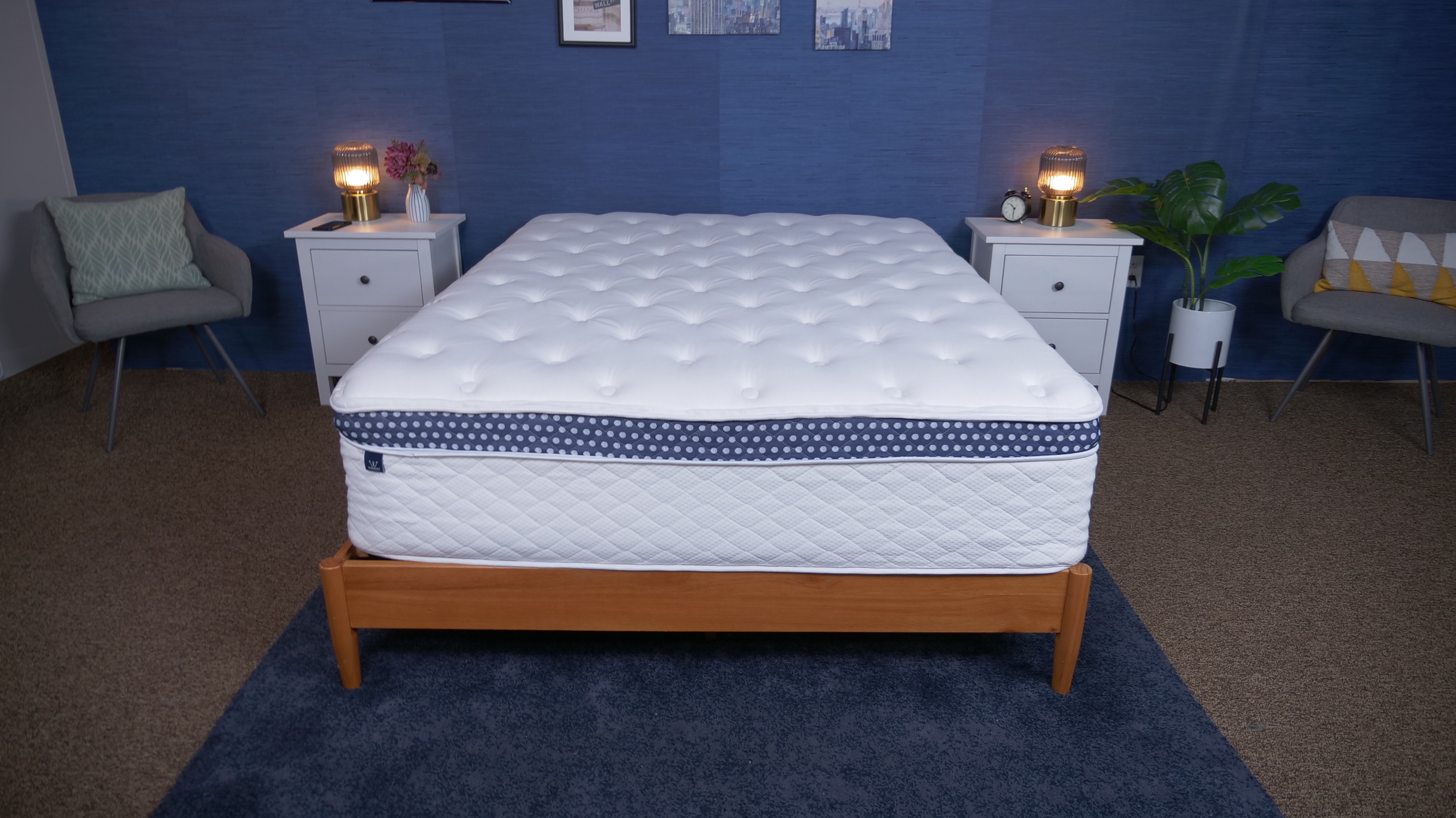
|
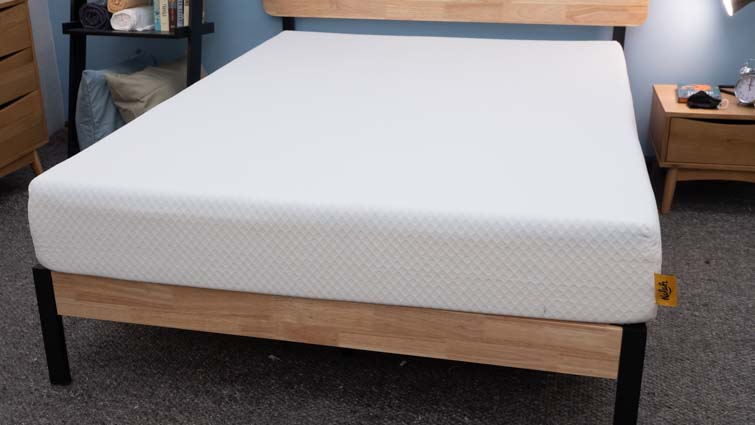
|
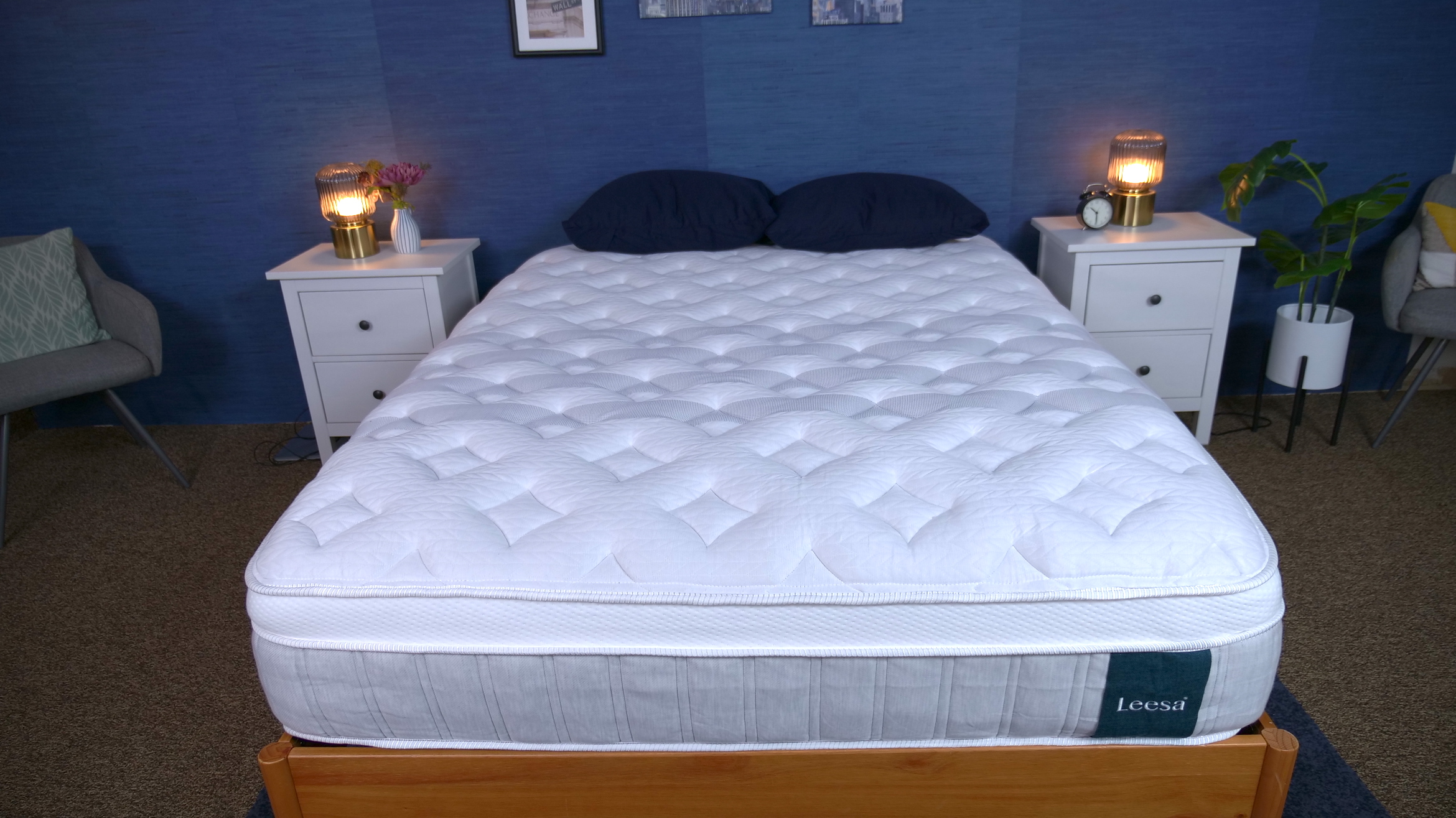
|
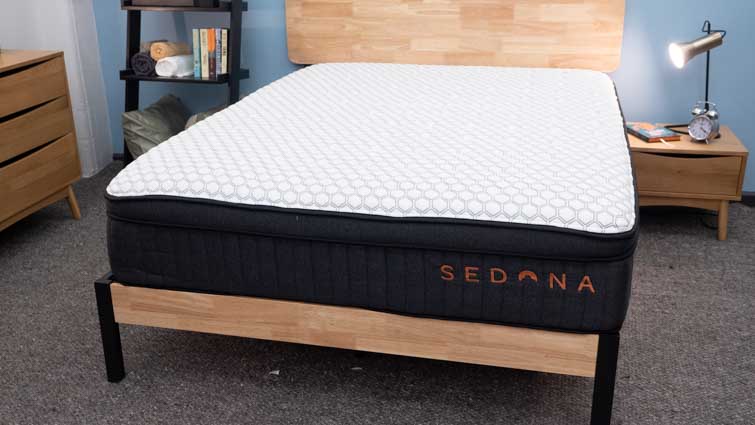
|
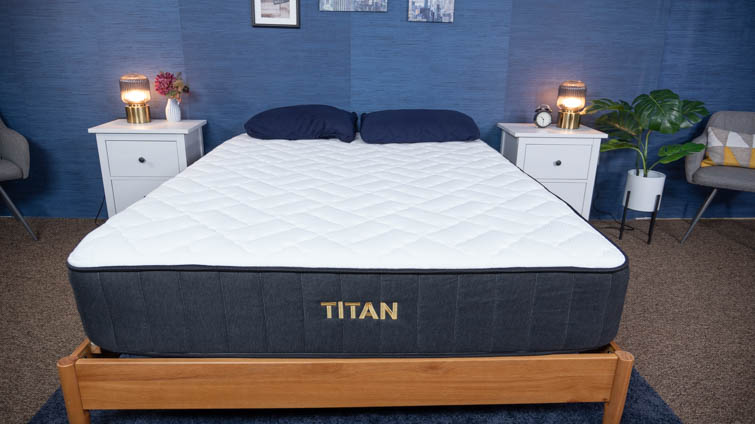
|
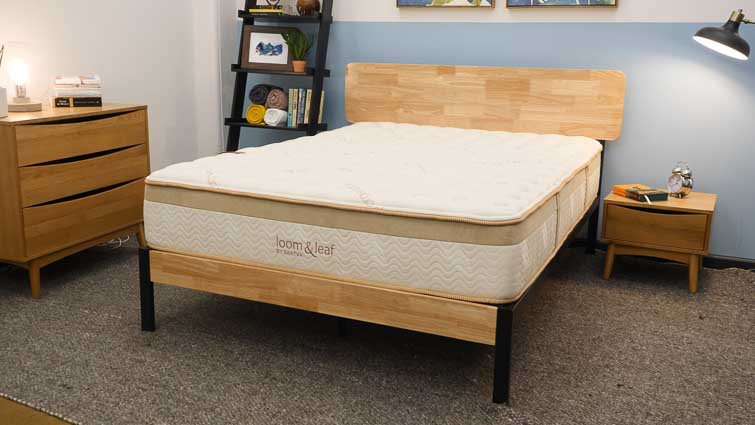
|
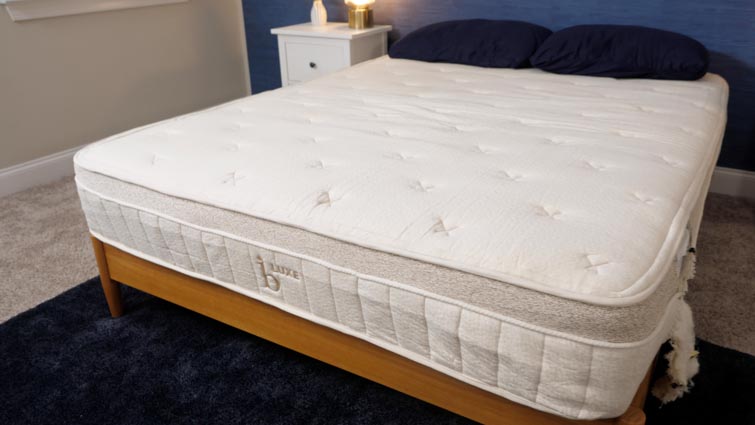
|
|
| Helix Dusk Luxe Mattress | Emma Hybrid Comfort | Saatva Mattress | WinkBed Plus Mattress | Nolah Original 10″ Mattress | Leesa Sapira Chill Hybrid | Brooklyn Bedding Sedona Elite Mattress | Titan Plus | Loom & Leaf Mattress | Birch Luxe Natural Mattress | |
| Rating | ||||||||||
| Firmness | Firm: 7.5/10 | Multiple firmness options | Firm: 7.5/10 | Multiple firmness options | Firm: 7.5/10 | Firm: 7/10 | ||||
| Material | Hybrid | Hybrid | Innerspring | Hybrid | Foam | Hybrid | Hybrid | Hybrid | Foam | Hybrid |
| Cooling |
|
|
|
|
— | — |
|
— | — | — |
| Warranty | 15-year warranty | 10-year warranty | Lifetime warranty | Lifetime warranty | Lifetime warranty | 10-year warranty | 10-year warranty | 10-year warranty | Lifetime warranty | 25-year warranty |
| Shipping | Free shipping | Free shipping | Free white glove delivery | Free shipping | Free shipping | Free shipping | Free shipping | Free shipping | Free shipping | Free shipping |
| Trial Period | 100 nights | 365 nights | 365 nights | 120 nights | 120 nights | 100 nights | 120 nights | 120 nights | 365 nights | 100 Nights |
| Best For | Stomach Sleepers, Back Sleepers, Side Sleepers, Hot Sleepers | Back Sleepers, Stomach Sleepers, Hot Sleepers | Back Sleepers, Stomach Sleepers, Back Pain, Hot Sleepers | Back Sleepers, Stomach Sleepers, Hot Sleepers | Side Sleepers, Back Sleepers | Side Sleepers, Back Sleepers, Stomach Sleepers | Side Sleepers, Hot Sleepers, Couples | Back Sleepers, Stomach Sleepers, Back Pain | Back Pain, Side Sleepers | Back Sleepers, Stomach Sleepers |
Helix Dusk Luxe – Best Overall
The Helix Dusk Luxe mattress features great edge support and a medium-firm feel. It’s made with a top layer of latex-foam alternative making it more durable than traditional memory foam. It's also bouncy, which is a plus for combination sleepers.
We recommend this mattress for the following sleeper types: Financing options are available for this mattress. The Helix Dusk Luxe mattress features great edge support and a medium-firm feel. It’s made with a top layer of latex-foam alternative making it more durable than traditional memory foam. It's also bouncy, which is a plus for combination sleepers.
We recommend this mattress for the following sleeper types: Financing options are available for this mattress. The Helix Dusk Luxe mattress features great edge support and a medium-firm feel. It’s made with a top layer of latex-foam alternative making it more durable than traditional memory foam. It's also bouncy, which is a plus for combination sleepers.
We recommend this mattress for the following sleeper types: Financing options are available for this mattress.Helix Dusk Luxe Mattress

Material
Hybrid
Trial Period
100 nights
Shipping Method
Free shipping
Firmness
Medium-firm: 6.5/10
Warranty
15-year warranty
Price Range
$$$$$
Hot Sleepers
If you often overheat while you sleep, this mattress should help you stay cool.
Back Sleeping
Ideal for average weight and heavyweight back sleepers.
Side Sleeping
Ideal for heavyweight side sleepers.
Stomach Sleeping
Ideal for lightweight stomach sleepers.
Financing Options
Helix Dusk Luxe Mattress

Material
Hybrid
Warranty
15-year warranty
Firmness
Medium-firm: 6.5/10
Shipping Method
Free shipping
Trial Period
100 nights
Price Range
$$$$$
Hot Sleepers
If you often overheat while you sleep, this mattress should help you stay cool.
Back Sleeping
Ideal for average weight and heavyweight back sleepers.
Side Sleeping
Ideal for heavyweight side sleepers.
Stomach Sleeping
Ideal for lightweight stomach sleepers.
Financing Options

Helix Dusk Luxe Mattress
Material
Hybrid
Firmness
Medium-firm: 6.5/10
Trial Period
100 nights
Warranty
15-year warranty
Shipping Method
Free shipping
Price Range
$$$$$
Hot Sleepers
If you often overheat while you sleep, this mattress should help you stay cool.
Back Sleeping
Ideal for average weight and heavyweight back sleepers.
Side Sleeping
Ideal for heavyweight side sleepers.
Stomach Sleeping
Ideal for lightweight stomach sleepers.
Financing Options
Expert Opinion
The Helix Dusk Luxe is one of Helix’s most popular beds in their luxe line, and our all-time favorite for couples. The mattress comes in two versions: the Standard and the Luxe, but if you have the means, we recommend opting for the Luxe model, as it boasts some impressive extra features like a cooling cover and enhanced lumbar support. Both options feature plush memory foam and pocketed coils, which create a combination of pressure relief and support. With a firmness level of 6.5 out of 10 and a true medium-firm feel, the Dusk Luxe should be a good fit for most back and side sleepers with back pain, as the cushioning will help prevent stiffness around these joints.
Why is this mattress great for couples? The coils in the Dusk Luxe’s hybrid construction, as well as the Tencel cover, allow for plenty of breathability, which helps couples feel cooler throughout the night, especially since two bodies create more heat than one. The Helix Dusk Luxe also scored well on the edge support test. While sitting and lying towards the edge of the mattress, we found it has an incredibly strong perimeter. Partners will be able to make greater use of the mattress surface and sleep towards the edge of the bed, enhancing overall comfort.
What our tester says: “In general, we think the Helix Dusk beds are springy and responsive, which makes them good for sex. However, if you’re easily disturbed by a partner moving around at night, we recommend that you opt for a different mattress.” – Bridget Chapman, former senior product editor
What Customers Say
According to customer reviews on the Helix website, the Helix Dusk Luxe has greatly helped those with back pain, with many users saying they haven’t experienced any pain since buying the mattress. Many reviews also state that this is the first mattress they’ve used without a mattress topper, thanks to the cushiony nature of the Helix Dusk Luxe.
Pros of the Helix Dusk Luxe Mattress
- The Helix Dusk Luxe, for all of its enhanced features, comes at a spectacular value (especially with Helix’s frequent sales and discounts).
- It’s responsive, meaning it’s easy to move around on. This makes it an ideal option for combination sleepers or sex.
- This mattress includes a comfort layer made of memory plus foam. This allows the mattress to contour to the sleeper’s body and provide additional pressure relief.
Cons of the Helix Dusk Luxe Mattress
- For heavier sleepers, the softness of this mattress isn’t likely to give them the support they need. These sleepers could try the Plus version of the Helix, which was made with larger bodies in mind. They can also check out our best mattresses for heavy people to find the right fit for them.
Read more about the Helix Dusk Luxe in our full review and get our best deal here. You can also check out our roundup of the best mattresses.
Emma Hybrid Comfort – Best Hybrid Mattress for Couples
The Emma Hybrid Comfort is a firm, supportive, and bouncy mattress. A good fit for back sleepers and stomach sleepers, it also has open-celled foam for cooling.
We recommend this mattress for the following sleeper types: Financing options are available for this mattress. The Emma Hybrid Comfort is a firm, supportive, and bouncy mattress. A good fit for back sleepers and stomach sleepers, it also has open-celled foam for cooling.
We recommend this mattress for the following sleeper types: Financing options are available for this mattress. The Emma Hybrid Comfort is a firm, supportive, and bouncy mattress. A good fit for back sleepers and stomach sleepers, it also has open-celled foam for cooling.
We recommend this mattress for the following sleeper types: Financing options are available for this mattress.Emma Hybrid Comfort

Material
Hybrid
Trial Period
365 nights
Shipping Method
Free shipping
Firmness
Firm: 7.5/10
Warranty
10-year warranty
Price Range
$$$$$
Hot Sleepers
If you often overheat while you sleep, this mattress should help you stay cool.
Back Sleeping
Ideal for average weight and heavyweight back sleepers.
Stomach Sleeping
Ideal for lightweight and heavyweight stomach sleepers.
Financing Options
Emma Hybrid Comfort

Material
Hybrid
Warranty
10-year warranty
Firmness
Firm: 7.5/10
Shipping Method
Free shipping
Trial Period
365 nights
Price Range
$$$$$
Hot Sleepers
If you often overheat while you sleep, this mattress should help you stay cool.
Back Sleeping
Ideal for average weight and heavyweight back sleepers.
Stomach Sleeping
Ideal for lightweight and heavyweight stomach sleepers.
Financing Options

Emma Hybrid Comfort
Material
Hybrid
Firmness
Firm: 7.5/10
Trial Period
365 nights
Warranty
10-year warranty
Shipping Method
Free shipping
Price Range
$$$$$
Hot Sleepers
If you often overheat while you sleep, this mattress should help you stay cool.
Back Sleeping
Ideal for average weight and heavyweight back sleepers.
Stomach Sleeping
Ideal for lightweight and heavyweight stomach sleepers.
Financing Options
Expert Opinion
We think the Emma Hybrid Comfort is an excellent choice for both heavy sleepers (those over 250 pounds) and couples. It’s able to contour sleepers while also providing ample support. There are seven different zones in the support layer of coils (i.e. areas with different levels of firmness) to help keep the sleeper’s weight evenly distributed. The Emma Hybrid Comfort also includes a top cover made of heat-wicking materials to cool down the mattress. Additionally, the foams and coils keep the mattress extra bouncy, helping sleepers easily move around.
For couples, the Emma Hybrid Comfort had a stellar score on our motion transfer test. This test is conducted by dropping a 10-pound steel ball onto the mattress at three different heights. Then, a seismometer is used to measure the transfer of motion from one side of the bed to the other. The Hybrid Comfort’s low vibrations mean that couples aren’t likely to wake each other up throughout the night with tossing and turning.
What our tester says: “The Emma mattress’s supportive foam layers and responsive coil system make it a fantastic choice for couples who prioritize motion isolation and mobility.” – Amelia Jerden, senior staff writer
What Customers Say
The majority of customers on the Emma website talked about how good this mattress is for couples, especially when one partner is a restless sleeper. This mattress allowed them to have uninterrupted sleep all night long, despite their partner. Many reviews also added that the coolness of Emma Hybrid Comfort helped alleviate their night sweats.
Pros of the Emma Hybrid Comfort Mattress
- Sleepers with back pain will enjoy the Emma Hybrid Comfort because of its ability to relieve pressure. During the pressure map test, where our Sleepopolis mattress tester lays in different positions on top of a pressure map, the back area was completely blue, meaning that there was no pressure forming. This will help alleviate back pain throughout the night.
- Combination sleepers will appreciate the bounciness of this mattress because it allows them to switch into multiple positions throughout the night.
- The open-cell foam and pocketed springs in the Emma Hybrid Comfort help to promote airflow. Sleepers looking for a mattress that stays cool throughout the night should appreciate the breathability present in this mattress.
Cons of the Emma Hybrid Comfort Mattress
- Lightweight sleepers might find this mattress to be too firm for their liking, especially if they are strict side sleepers. This kind of sleeper will want to opt for a softer mattress that can better support their hips and shoulders. If this sounds like you, check out our roundup for the best soft mattresses.
If you’re wanting to purchase the Emma Hybrid Comfort, get our best deal here. Still thinking about it? Check out our full Emma Hybrid Comfort mattress review, or learn more about the best hybrid mattresses.
Saatva – Best Mattress for Sex
The Saatva’s coil-on-coil construction provides a classic innerspring feel. It's a good option for combo sleepers, who will want to feel free to switch positions and avoid feeling “stuck” in the mattress. It comes in three firmness levels, so you should be able to find one that suits your needs.
We recommend this mattress for the following sleeper types: Financing options are available for this mattress. We were skeptical of buying a mattress on line but it could not have gone any smoother. Anthony answered all of our questions during our many phone conversations. Delivery was prompt and went without a hitch. Best of all the mattress is so comfortable! I haven't had such a good night sleep in years. Highly recommend this.
The Saatva’s coil-on-coil construction provides a classic innerspring feel. It's a good option for combo sleepers, who will want to feel free to switch positions and avoid feeling “stuck” in the mattress. It comes in three firmness levels, so you should be able to find one that suits your needs.
We recommend this mattress for the following sleeper types: Financing options are available for this mattress. We were skeptical of buying a mattress on line but it could not have gone any smoother. Anthony answered all of our questions during our many phone conversations. Delivery was prompt and went without a hitch. Best of all the mattress is so comfortable! I haven't had such a good night sleep in years. Highly recommend this.
The Saatva’s coil-on-coil construction provides a classic innerspring feel. It's a good option for combo sleepers, who will want to feel free to switch positions and avoid feeling “stuck” in the mattress. It comes in three firmness levels, so you should be able to find one that suits your needs.
We recommend this mattress for the following sleeper types: Financing options are available for this mattress. We were skeptical of buying a mattress on line but it could not have gone any smoother. Anthony answered all of our questions during our many phone conversations. Delivery was prompt and went without a hitch. Best of all the mattress is so comfortable! I haven't had such a good night sleep in years. Highly recommend this.
Saatva Mattress

Material
Innerspring
Trial Period
365 nights
Shipping Method
Free white glove delivery
Firmness
Multiple firmness options
Warranty
Lifetime warranty
Price Range
$$$$$
Hot Sleepers
If you often overheat while you sleep, this mattress should help you stay cool.
Back Pain
This bed is perfect for anyone suffering from back pain.
Back Sleeping
Ideal for lightweight, average weight, and heavyweight back sleepers.
Stomach Sleeping
Ideal for lightweight and average weight stomach sleepers.
Financing Options
Saatva Mattress

Material
Innerspring
Warranty
Lifetime warranty
Firmness
Multiple firmness options
Shipping Method
Free white glove delivery
Trial Period
365 nights
Price Range
$$$$$
Hot Sleepers
If you often overheat while you sleep, this mattress should help you stay cool.
Back Pain
This bed is perfect for anyone suffering from back pain.
Back Sleeping
Ideal for lightweight, average weight, and heavyweight back sleepers.
Stomach Sleeping
Ideal for lightweight and average weight stomach sleepers.
Financing Options

Saatva Mattress
Material
Innerspring
Firmness
Multiple firmness options
Trial Period
365 nights
Warranty
Lifetime warranty
Shipping Method
Free white glove delivery
Price Range
$$$$$
Hot Sleepers
If you often overheat while you sleep, this mattress should help you stay cool.
Back Pain
This bed is perfect for anyone suffering from back pain.
Back Sleeping
Ideal for lightweight, average weight, and heavyweight back sleepers.
Stomach Sleeping
Ideal for lightweight and average weight stomach sleepers.
Financing Options
Expert Opinion
The Saatva Classic is an innerspring mattress that comes in three different firmness options (Plush Soft, Luxury Firm, and Firm) and two different heights (11.5-inch and 14.5-inch). This allows shoppers to truly find the best fit for them. Being an innerspring mattress, the Saatva has plenty of support to keep the spine in a neutral alignment, which is great for back sleepers and heavier sleepers who want a mattress that stays durable for longer. The sturdy materials also provide a lot of bounce, which is great for sex. Couples should be able to move around on the Saatva’s coils throughout the night, whether they’re engaging in amorous activities or simply switching sleeping positions.
As for other factors that appeal to couples, the Saatva includes a pocketed coil section that helps the mattress stay cool throughout the night, especially when there are two sleepers in the bed. The perimeter is made with reinforced edge support that combines coil and poly foam, ensuring that one sleeper won’t fall off the bed in the middle of the night. While the high motion transfer might make this mattress difficult for light sleepers who might feel their partner tossing and turning at night, the bouncy material also helps couples move around on top of the mattress, again making the Saatva one of the best mattresses for sex.
What our tester says: “Couples could find a lot to love in the Saatva. It’s super supportive, plush, and has a high-quality feel. I also like how the organic cotton cover is breathable and cozy.” – Bridget Chapman, former senior product editor
What Customers Say
In looking at the online reviews on the Saatva website, many customers were praising the stellar customer service that allowed them to mattress shop without stress. Many reviews also noted the quick and convenient shipment of the mattress, which is complete with a free white-glove delivery, so the mattress is set up in your bedroom without you having to lift a finger.
Pros of the Saatva Mattress
- The Saatva’s supportive materials, along with its quilted Euro pillow top, make it a great option for sleepers with back pain. The quilted top helps alleviate pressure from the mattress, while the support system below keeps the sleeper’s spine in a neutral alignment.
- The responsive nature of the Saatva Classic makes it an especially helpful mattress for combination sleepers who need to switch positions throughout the night. This comes from the support layer in the mattress, which includes individually wrapped coils that conform to your body, providing bounce and support.
- Heavier sleepers will enjoy this mattress because of the study materials used to make it. Complete with five different layers, the Saatva Classic is designed around durability.
Cons of the Saatva Mattress
- As an innerspring mattress without memory foam, the Luxury Firm model of the Saatva (the one we tested) might be too firm for strict side sleepers, especially those who are lightweight, or who need more pressure relief for their shoulders and hips. These sleepers may want to opt for the Plush Soft firmness on the Saatva mattress, or check out our guide for the best mattress for side sleepers.
Want to learn more about the Saatva Classic? Read our full Saatva Classic mattress review. Or if you already love it, click here for our best deal. For even more options, check out our best mattresses for sex.
WinkBed Plus – Best Mattress for Heavy Couples
The WinkBeds Plus isn't just designed for heavier sleepers to feel more comfortable — it's also made to be longer-lasting. We recommend this mattress for the following sleeper types: Financing options are available for this mattress. The WinkBeds Plus isn't just designed for heavier sleepers to feel more comfortable — it's also made to be longer-lasting. We recommend this mattress for the following sleeper types: Financing options are available for this mattress. The WinkBeds Plus isn't just designed for heavier sleepers to feel more comfortable — it's also made to be longer-lasting. We recommend this mattress for the following sleeper types: Financing options are available for this mattress.WinkBed Plus Mattress

Material
Hybrid
Trial Period
120 nights
Shipping Method
Free shipping
Firmness
Firm: 7.5/10
Warranty
Lifetime warranty
Price Range
$$$$$
Hot Sleepers
If you often overheat while you sleep, this mattress should help you stay cool.
Back Sleeping
Ideal for heavyweight back sleepers.
Stomach Sleeping
Ideal for heavyweight stomach sleepers.
Financing Options
WinkBed Plus Mattress

Material
Hybrid
Warranty
Lifetime warranty
Firmness
Firm: 7.5/10
Shipping Method
Free shipping
Trial Period
120 nights
Price Range
$$$$$
Hot Sleepers
If you often overheat while you sleep, this mattress should help you stay cool.
Back Sleeping
Ideal for heavyweight back sleepers.
Stomach Sleeping
Ideal for heavyweight stomach sleepers.
Financing Options

WinkBed Plus Mattress
Material
Hybrid
Firmness
Firm: 7.5/10
Trial Period
120 nights
Warranty
Lifetime warranty
Shipping Method
Free shipping
Price Range
$$$$$
Hot Sleepers
If you often overheat while you sleep, this mattress should help you stay cool.
Back Sleeping
Ideal for heavyweight back sleepers.
Stomach Sleeping
Ideal for heavyweight stomach sleepers.
Financing Options
A Note On Weight and Body Type
We recognize that people come in all shapes and sizes, and people of every size deserve a mattress that works for their body type. We use the weight categories light, average, and heavy to more easily categorize sleepers based on how mattresses will perform for their body type, as most mattresses are designed for the group we call “average” (130 to 250 pounds). We consider heavy sleepers to be anyone over 250 pounds, and they tend to need more support to prevent them from sinking too far into the layers.
Expert Opinion
The WinkBeds Plus mattress is a version of the WinkBed made specifically for individuals over 250 pounds. Its hybrid design maximizes pressure relief while providing added comfort to the sleeper. We made sure this was accurate by having a heavier sleeper test the WinkBed Plus. For them, the mattress mattress felt comfortable and scored a 7.5 on our firmness scale. However, for lightweight sleepers, the WinkBed Plus scores closer to an 8 on the firmness scale, which might be too firm for some side sleepers that prefer a softer mattress.
Switching to the comfort of couples, the hybrid construction of the WinkBed Plus should help them sleep cool. This is especially important when there is double the body heat in the bed. This mattress is also constructed with a Tencel cover that encourages breathability throughout the night. And with an Extra-Edge Support System included, the WinkBed Plus has strong edge support, which is important for couples who want to spread out on the mattress without feeling the edges sag underneath them. This mattress also has low motion transfer, which we tested using a seismometer to see how much motion was transferred from a 10-pound steel ball from one side of the mattress to the other. We don’t think couples — even heavier ones — will feel each other tossing or turning during the night.
What our tester says: “The WinkBed Plus achieves a stellar balance of firmness, support, and cushioning that should work great for a lot of heavy folks. I appreciate the durable materials that will not only keep sleepers properly supported, but will also allow the bed to last a long time.” – Bridget Chapman, senior product editor
What Customers Say
While reading through the reviews on the WinkBed website, we found that almost every single user commented on their relief from back pain, with one even saying that this was their first night’s sleep without back pain in nine years. Many reviews also spoke on the hybrid construction of this mattress, which allows sleepers to feel supported and comfortable at the same time.
Pros of the WinkBed Plus Mattress
- Sleepers with shoulder pain should feel extra comfortable on this mattress because of its pressure relieving capabilities. This is particularly true for those that sleep on their back or stomach for the majority of the night.
- The hybrid quality of this mattress makes it good for combination sleepers. They will be able to move around easily on top of the WinkBed Plus and won’t feel “stuck” in the mattress.
- Back sleepers should enjoy the WinkBed Plus because of its extra firm feel. This helps keep the spine supported in a neutral position throughout the night.
Cons of the WinkBed Plus Mattress
- This mattress is most likely too firm for the majority of side sleepers. Side sleepers need extra pressure relief for their hips and shoulders, which the WinkBed Plus might not provide because of its firm feel. If you prefer to sleep on your side, check out our best mattresses for side sleepers to find the right fit for you.
Sold on the WinkBed Plus for ultimate support? Get our best deal here and read our full review for more information. If you’re still looking, check out our other picks for the best mattress for heavy sleepers.
Nolah – Best Mattress for Side-Sleeping Couples
Side sleepers should really enjoy the pressure-relieving feel of the Nolah. It's great for couples because it absorbs motion well and stays quite cool. Side sleepers should really enjoy the pressure-relieving feel of the Nolah. It's great for couples because it absorbs motion well and stays quite cool. Side sleepers should really enjoy the pressure-relieving feel of the Nolah. It's great for couples because it absorbs motion well and stays quite cool.Nolah Original 10" Mattress

Material
Foam
Trial Period
120 nights
Shipping Method
Free shipping
Firmness
Medium-firm: 6.5/10
Warranty
Lifetime warranty
Price Range
$$$$$
Nolah Original 10" Mattress

Material
Foam
Warranty
Lifetime warranty
Firmness
Medium-firm: 6.5/10
Shipping Method
Free shipping
Trial Period
120 nights
Price Range
$$$$$

Nolah Original 10" Mattress
Material
Foam
Firmness
Medium-firm: 6.5/10
Trial Period
120 nights
Warranty
Lifetime warranty
Shipping Method
Free shipping
Price Range
$$$$$
Expert Opinion
The Nolah is created with a proprietary material called Nolah Airfoam. It’s able to contour the body like memory foam, while also making sure not to overheat the sleepers. Its slow response to pressure should be a good fit for side sleepers, allowing them to sink into the bed without putting pressure on their hips or shoulders. At the same time, there is a little bit of bounce, so combination sleepers should still be able to move around easily on top of the mattress.
The Nolah has good motion isolation, which we test by dropping a 10-pound steel ball from three different heights onto a mattress. We them use a seismometer to see how much motion is transferred from one side of the bed to the other. A bed with good motion isolation — like the Nolah — should keep partners from feeling each other’s movement during the night. And while the Nolah is especially cushy because of the foam used in its construction, it is still easy to move around on top of the mattress, making it good for sex.
What our tester says: “I really enjoyed the body-contouring hug the Nolah mattress offered, especially while I was on my back. If you’re someone who struggles with back pain, the Nolah could be a good solution for you. In general, I’d say back and side sleepers could especially enjoy this mattress.” – Madison Schaper, former Sleepopolis staff writer and mattress tester
What Customers Say
Customers who previously had lower back or hip pain praise this mattress in the reviews on the Nolah website. Couples also comment on the motion isolation of the Nolah, stating that they no longer feel their partner moving throughout the night.
Pros of the Nolah Mattress
- The cushiony feel of the Nolah is a good fit for sleepers who may suffer from joint pain or arthritis. The foam in this mattress should help to relieve the pressure around these sleepers’ joints.
- The Tencel cover included on the Nolah mattress is created using recycled materials, which is particularly important for eco-friendly shoppers.
- We found that the Nolah really did sleep cooler than most mattresses made from foam.
Cons of the Nolah Mattress
- Both stomach sleepers and heavier sleepers (those over 250 pounds) will most likely want to find a mattress that includes some sort of innerspring support. This helps keep the mattress durable over time, and stomach sleepers will appreciate how a innerspring mattress keeps their hips in line with their spine. Check out our roundup for the best innerspring mattresses if you’re a stomach sleeper or have a heavier build.
If you’re ready for the Nolah to cradle your hips and shoulder, get our best deal here. Still thinking about it? Check out our full review or read more of the best mattresses for side sleepers.
Leesa Sapira Chill – Best Mattress for Back-Sleeping Couples
Leesa Sapira Chill Hybrid

The Leesa Sapira Chill is a plush, supportive hybrid mattress that comes in three different firmness levels.
Material
Hybrid
Trial Period
100 nights
Shipping Method
Free shipping
Firmness
Multiple firmness options
Warranty
10-year warranty
Price Range
$$$$$
We recommend this mattress for the following sleeper types:
Back Sleeping
Ideal for lightweight, average weight, and heavyweight back sleepers.Side Sleeping
Ideal for lightweight and average weight side sleepers.Stomach Sleeping
Ideal for lightweight and average weight stomach sleepers.Financing Options
Financing options are available for this mattress.
Leesa Sapira Chill Hybrid

The Leesa Sapira Chill is a plush, supportive hybrid mattress that comes in three different firmness levels.
Material
Hybrid
Warranty
10-year warranty
Firmness
Multiple firmness options
Shipping Method
Free shipping
Trial Period
100 nights
Price Range
$$$$$
We recommend this mattress for the following sleeper types:
Back Sleeping
Ideal for lightweight, average weight, and heavyweight back sleepers.Side Sleeping
Ideal for lightweight and average weight side sleepers.Stomach Sleeping
Ideal for lightweight and average weight stomach sleepers.Financing Options
Financing options are available for this mattress.

Leesa Sapira Chill Hybrid
The Leesa Sapira Chill is a plush, supportive hybrid mattress that comes in three different firmness levels.
Material
Hybrid
Firmness
Multiple firmness options
Trial Period
100 nights
Warranty
10-year warranty
Shipping Method
Free shipping
Price Range
$$$$$
We recommend this mattress for the following sleeper types:
Back Sleeping
Ideal for lightweight, average weight, and heavyweight back sleepers.Side Sleeping
Ideal for lightweight and average weight side sleepers.Stomach Sleeping
Ideal for lightweight and average weight stomach sleepers.Financing Options
Financing options are available for this mattress.
Expert Opinion
The Leesa Sapira Chill is a hybrid mattress that comes in three different firmness options, Soft, Medium-Firm, and Firm. For our Sleepopolis mattress review, we tested the Medium-Firm model, and think it should accommodate back sleepers of a number of different body types. Our pressure map test showed some impressive results in the back- and side-sleeping positions. While on your back, the foam comfort layer should fill in the lumbar region and provide some cushioning. Meanwhile, the layer of support coils provides the lift you need to maintain a healthy alignment through the night.
Of course, the Sapira Chill wouldn’t be on this roundup if it wasn’t good for couples. During testing, it received scores of at least 4 out of 5 in motion isolation, edge support, and cooling.
What our tester says: “When I first laid down on the Leesa Sapira Chill, I immediately noticed its plush yet supportive feel where I felt I was sleeping ‘on’ the bed rather than ‘in’ it. It’s very responsive and has good bounce — thanks to the reinforced pocketed springs — so I felt comfortably lifted and had no trouble moving around and shifting positions.” – Bridget Chapman, former senior product editor
What Customers Say
In customer reviews, folks seem to appreciate the Greenguard GOLD certification that this mattress earned because of its safe materials and low VOC emissions.
Pros of the Leesa Sapira Chill Mattress
- The Sapira Chill is a wonderful choice for cooling, as it includes cooling technology in its cover, comfort layer, and support layer.
- Lightweight sleepers, average weight sleepers, and heavier sleepers of all sleeping positions should be able to find a model that works for them.
- The Leesa Sapira has a responsive feel that allows combination sleepers to move around without trouble.
Cons of the Leesa Sapira Chill Mattress
- Budget-conscious shoppers might want to look elsewhere for their mattress. It comes with a price tag that matches the design. If you’re looking for a more affordable mattress, check out our roundup of the best mattresses under $1,000.
Does the Leesa Sapira Chill sound like the right mattress for you? Click here to get our best deals, or read more about this mattress in our full Leesa Sapira Chill mattress review. Looking for other choices? Take a look out our roundup of the best mattresses for back sleepers.
Brooklyn Bedding Sedona – Best Pressure-Relieving Mattress for Couples
The Brooklyn Bedding Sedona has a soft, pressure-relieving feel that’s great for couples with pain concerns. It also offers plenty of sturdy support. We recommend this mattress for the following sleeper types: Financing options are available for this mattress. The Brooklyn Bedding Sedona has a soft, pressure-relieving feel that’s great for couples with pain concerns. It also offers plenty of sturdy support. We recommend this mattress for the following sleeper types: Financing options are available for this mattress. The Brooklyn Bedding Sedona has a soft, pressure-relieving feel that’s great for couples with pain concerns. It also offers plenty of sturdy support. We recommend this mattress for the following sleeper types: Financing options are available for this mattress.Brooklyn Bedding Sedona Elite Mattress

Material
Hybrid
Trial Period
120 nights
Shipping Method
Free shipping
Firmness
Soft: 5/10
Warranty
10-year warranty
Price Range
$$$$$
Hot Sleepers
If you often overheat while you sleep, this mattress should help you stay cool.
Couples
This bed has great motion isolation so you will not feel your partner tossing and turning at night.
Side Sleeping
Ideal for lightweight and average weight side sleepers.
Financing Options
Brooklyn Bedding Sedona Elite Mattress

Material
Hybrid
Warranty
10-year warranty
Firmness
Soft: 5/10
Shipping Method
Free shipping
Trial Period
120 nights
Price Range
$$$$$
Hot Sleepers
If you often overheat while you sleep, this mattress should help you stay cool.
Couples
This bed has great motion isolation so you will not feel your partner tossing and turning at night.
Side Sleeping
Ideal for lightweight and average weight side sleepers.
Financing Options

Brooklyn Bedding Sedona Elite Mattress
Material
Hybrid
Firmness
Soft: 5/10
Trial Period
120 nights
Warranty
10-year warranty
Shipping Method
Free shipping
Price Range
$$$$$
Hot Sleepers
If you often overheat while you sleep, this mattress should help you stay cool.
Couples
This bed has great motion isolation so you will not feel your partner tossing and turning at night.
Side Sleeping
Ideal for lightweight and average weight side sleepers.
Financing Options
Expert Opinion
The Brooklyn Bedding Sedona is a hybrid mattress with both memory foam layers and individually wrapped coils in the construction. The Sedona has a firmness rating of 5.5 from our Sleepopolis testers, which is below the industry standard of 6.5 for a medium-firm mattress. This makes the Sedona extra soft, especially with the foam layers at the top that create a plush feel. This mattress allows sleepers to really “sink in” to the bed at night, which helps provide pressure relief around the hips and shoulders. This is especially great for side sleepers, who put the majority of their weight into their shoulders while sleeping.
The motion isolation present in this mattress is low, which is especially surprising for a mattress with coils. This makes the Sedona a great mattress for couples, since the slow-response foam layers and the Ascension X coils in this mattress will help keep movement from one partner isolated from the other during the night. The gel memory foam in the comfort layer of this mattress also helps keep couples cool throughout the night, which can be hard when there’s two people in one bed. Adding to this, the Sedona includes coils at its base, which helps air pass through easily so the mattress stays breathable.
What our tester says: “I’m happy to recommend this model to back sleepers looking for a soft feel to aid in pressure relief around their lumbar region. The foams cradle and support the body, but you aren’t likely to sink too far into the bed or feel like you’re stuck in quicksand.” – Logan Block, former Sleepopolis director of content and mattress tester
What Customers Say
Reviews on the Brooklyn Bedding website talk about how cooling this mattress felt to the majority of sleepers, most likely due to the cooling technology present in this model. Customers also state that the installation of the mattress was quick and easy, which is pleasantly surprising for a bed-in-a-box mattress.
Pros of the Brooklyn Bedding Sedona Mattress
- On the pressure map, which shows high pressure in red and low pressure in blue, the Sedona is entirely blue when it comes to back sleeping. This is important for those with back pain. The mattress cradles the body, relieving pressure from the lumbar region.
- Sleepers with shoulder pain should consider this model because of its pressure relief. If you are a side sleeper with shoulder pain, this mattress will specifically help alleviate pressure around the shoulders and hips, where most side sleepers put the majority of their weight.
- The multiple layers of foam in this mattress are great for sleepers who really want to “sink in” to their mattress. The extra soft feel and plush layers give a luxurious feel to the Sedona.
Cons of the Brooklyn Bedding Sedona Mattress
- Heavier sleepers may want to go for mattress that gives them more support than the Sedona can offer with its soft feel. Some heavy sleepers might feel like they’re going to fall through the Sedona, which does not create a relaxing sleeping experience. Instead, opt for one of the mattress on our roundup of best mattresses for heavy people.
Looking for a different mattress to relieve pressure? Check out some of our favorite soft mattresses. Is the Sedona right for you? Read our full review and get our best deal here.
Titan Plus – Best Mattress for Stomach-Sleeping Couples
The Titan Firm Hybrid from Brooklyn Bedding is a durable mattress featuring 6-inch heavy-duty support coils, making it a great option for heavier sleepers. This mattress also has a Titanflex foam comfort layer, which provides nice lift and bounce for heavier weights.
We recommend this mattress for the following sleeper types: Financing options are available for this mattress. Get this bed right now! Simply amazing. Does not sag in the middle at all. Best sleep I've had in a very long time.
The Titan Firm Hybrid from Brooklyn Bedding is a durable mattress featuring 6-inch heavy-duty support coils, making it a great option for heavier sleepers. This mattress also has a Titanflex foam comfort layer, which provides nice lift and bounce for heavier weights.
We recommend this mattress for the following sleeper types: Financing options are available for this mattress. Get this bed right now! Simply amazing. Does not sag in the middle at all. Best sleep I've had in a very long time.
The Titan Firm Hybrid from Brooklyn Bedding is a durable mattress featuring 6-inch heavy-duty support coils, making it a great option for heavier sleepers. This mattress also has a Titanflex foam comfort layer, which provides nice lift and bounce for heavier weights.
We recommend this mattress for the following sleeper types: Financing options are available for this mattress. Get this bed right now! Simply amazing. Does not sag in the middle at all. Best sleep I've had in a very long time.
Titan Plus

Material
Hybrid
Trial Period
120 nights
Shipping Method
Free shipping
Firmness
Firm: 7.5/10
Warranty
10-year warranty
Price Range
$$$$$
Back Pain
This bed is perfect for anyone suffering from back pain.
Back Sleeping
Ideal for heavyweight back sleepers.
Stomach Sleeping
Ideal for heavyweight stomach sleepers.
Financing Options
Titan Plus

Material
Hybrid
Warranty
10-year warranty
Firmness
Firm: 7.5/10
Shipping Method
Free shipping
Trial Period
120 nights
Price Range
$$$$$
Back Pain
This bed is perfect for anyone suffering from back pain.
Back Sleeping
Ideal for heavyweight back sleepers.
Stomach Sleeping
Ideal for heavyweight stomach sleepers.
Financing Options

Titan Plus
Material
Hybrid
Firmness
Firm: 7.5/10
Trial Period
120 nights
Warranty
10-year warranty
Shipping Method
Free shipping
Price Range
$$$$$
Back Pain
This bed is perfect for anyone suffering from back pain.
Back Sleeping
Ideal for heavyweight back sleepers.
Stomach Sleeping
Ideal for heavyweight stomach sleepers.
Financing Options
Expert Opinion
Brooklyn Bedding designed their luxury hybrid Titan Plus mattress specifically for heavy sleepers over 250 pounds. That means it should have an exceptionally high level of support. But we made sure to have a heavier sleeper test it so we could get accurate results. He found that it kept him properly elevated, even when he was on his stomach. His hips were lifted up and in line with his shoulders, helping keep his spine in a neutral alignment. He also found the mattress to be especially firm. When we combined his firmness score with the ratings of several other Sleepopolis testers, the bed came in at an average of 7.5 out of 10 on our mattress firmness scale. And because the Titan Plus is on our best mattress for couples roundup, we of course had to test how it should feel for anyone who sleeps with a partner.
Most couples are looking for a cool mattress with solid edge support and low motion transfer. The Titan Plus has strong edge support, so both couples and heavier sleepers can turn over and sleep close to the edge of the mattress without fear of sinkage or sagging. It also has low motion transfer, mainly because of its flexible top layer that stops movement from one side of the mattress before it can vibrate to the other side. We tested this by dropping a 10-pound steel ball from three different heights and measuring the motion from one side to the other using a seismometer. While the Titan Plus is not the most cooling mattress, it does have a support layer of six-inch 961 Titan Caliber encased coils, which give the construction some breathability by allowing for more airflow.
What our tester says: “The Titan Plus is a stomach sleeper’s dream! It’s very firm, but it also has a nice level of cushioning to it so you don’t feel pressure building up. It did a great job in our edge support test as well, so you can sleep right next to the side of the bed without feeling like it’s going to cave down beneath you.” – Bridget Chapman, former senior product editor
What Customers Say
While this is a bed-in-a-box mattress, the reviews left on the Titan website speak on how quickly the bed became fully fluffed out. Heavier sleepers also left reviews on this mattress, speaking to how comfortably they sleep through the night without feeling any pain, which wasn’t always the case with their previous mattresses.
Pros of the Titan Plus Mattress
- Combination sleepers should enjoy this mattress because of its firmness, which helps them move around freely in order to switch positions throughout the night.
- The coils present in the construction of the Titan Plus help to lift sleeper’s hips and align them with their shoulders. This is important for those suffering from hip pain, as they need more pressure relief from their mattress.
- The Titan Plus comes with a quilted top cover made of polyester, which makes the top of the mattress a little cozier for sleepers. This cover is combined with an inch of gel memory, so sleepers should immediately feel the comforting effect of this mattress when lying down.
Cons of the Titan Plus Mattress
- Strict side sleepers will most likely not receive the pressure relief they need from the Titan Plus, especially around their hips and shoulders, where they need a softer pressure beneath them that cannot be found with this firm mattress. If this sounds like you, opt for one of the mattress in our best mattresses for side sleepers instead.
Curious to know more? Read our full Titan Plus mattress review. Or if you’re confident this is the best mattress for you, click here to get our best deal. For more options, take a peek at our best mattresses for stomach sleepers.
Loom & Leaf – Best Luxury Mattress for Couples
The Loom & Leaf is a pressure-relieving memory foam mattress. It offers deep sinkage and contouring, and its foam layers absorb almost all movement, making it a great option for couples.
The Loom & Leaf is a pressure-relieving memory foam mattress. It offers deep sinkage and contouring, and its foam layers absorb almost all movement, making it a great option for couples.
The Loom & Leaf is a pressure-relieving memory foam mattress. It offers deep sinkage and contouring, and its foam layers absorb almost all movement, making it a great option for couples.
Loom & Leaf Mattress

Material
Foam
Trial Period
365 nights
Shipping Method
Free shipping
Firmness
Multiple firmness options
Warranty
Lifetime warranty
Price Range
$$$$$
Loom & Leaf Mattress

Material
Foam
Warranty
Lifetime warranty
Firmness
Multiple firmness options
Shipping Method
Free shipping
Trial Period
365 nights
Price Range
$$$$$

Loom & Leaf Mattress
Material
Foam
Firmness
Multiple firmness options
Trial Period
365 nights
Warranty
Lifetime warranty
Shipping Method
Free shipping
Price Range
$$$$$
Expert Opinion
If you and your partner are wanting to sleep like royalty, purchasing a Loom & Leaf is certainly a step in the right direction. This luxury mattress is an all-foam option with two different firmnesses to choose from: Relaxed Firm and Firm. During testing, we rated the Relaxed Firm a 6 out of 10 (medium), and the Firm an 8 out of 10 (firm). Folks of all sleeping positions and body types should find that one of the two options works well for them.
What’s so special about the Loom & Leaf is its luxurious and high-quality materials, from its organic cotton cover to its high-density support layer. We put this mattress to the test and found that it especially excels in motion isolation. Our seismograph test showed little disturbance and revealed that it’s a good choice for light sleepers.
What our tester says: “This could be an excellent bed for folks who love memory foam. This bed features two thick top layers of the pressure-relieving material. I think side sleepers should do especially well on this bed as they experience cushiony support at the shoulders and hips.” – Logan Block, former content director
What Customers Say
After reading the reviews on the Saatva website, the majority of customers are commenting on the motion isolation in this mattress. Most couples cannot feel their partners move throughout the night, allowing them to sleep longer without disruption from the other side of the bed.
Pros of the Loom & Leaf Mattress
- Sleepers of all body types and positions should find comfort on the Loom & Leaf. The Relaxed Firm should be a good option for side sleepers and back sleepers under 250 pounds. Other folks who need more support, such as back sleepers over 130 pounds and stomach sleepers, should stick with the Firm version.
- The Loom & Leaf has strong edge support, which is an indicator of durability.
- Sleepers suffering from back pain will find that the firm side of the Loom & Leaf helps alleviate that pain. In the pressure map test, back sleeping showed almost no pressure, lighting up with blue and only a touch of green.
Cons of the Loom & Leaf Mattress
- This bed should be alright for most sleepers in terms of temperature, as there’s a layer of cooling gel-infused foam. However, if you sleep extra-hot, you might want a more cooling option like the Saatva Classic.
Flipping out over the Loom & Leaf? Get our best deal here. And you can of course learn more about the mattress in our full Loom & Leaf mattress review. Still looking for your perfect mattress? Check out more picks for the best luxury mattress.
Birch Luxe – Best Cooling Mattress for Couples
The Birch Luxe mattress is an eco-friendly and plush hybrid mattress by Helix Sleep. It's designed to sleep cool and assist with muscle recovery.
The Birch Luxe mattress is an eco-friendly and plush hybrid mattress by Helix Sleep. It's designed to sleep cool and assist with muscle recovery.
The Birch Luxe mattress is an eco-friendly and plush hybrid mattress by Helix Sleep. It's designed to sleep cool and assist with muscle recovery.
Birch Luxe Natural Mattress

Material
Hybrid
Trial Period
100 Nights
Shipping Method
Free shipping
Firmness
Firm: 7/10
Warranty
25-year warranty
Price Range
$$$$$
Birch Luxe Natural Mattress

Material
Hybrid
Warranty
25-year warranty
Firmness
Firm: 7/10
Shipping Method
Free shipping
Trial Period
100 Nights
Price Range
$$$$$

Birch Luxe Natural Mattress
Material
Hybrid
Firmness
Firm: 7/10
Trial Period
100 Nights
Warranty
25-year warranty
Shipping Method
Free shipping
Price Range
$$$$$
Expert Opinion
The Birch Luxe is an eco-friendly mattress created by Helix Sleep. It combines layers of wool and organic cashmere, bringing breathability and durability together in one mattress. With a 7 on the firmness scale, which is based on the opinions of our Sleepopolis mattress testers, the Birch Luxe is slightly firmer than the industry standard, which is set at a 6.5 for a medium-firm mattress. The majority of this firmness comes from the steel coils and latex used in the construction of the Birch Luxe, keeping the mattress supported and durable for longer. However, the organic cotton cover on the top of the mattress creates a plush feel for sleepers that want a little more comfort.
For an innerspring bed, the Birch Luxe has a relatively good score on the motion transfer test, which is based on how much motion is transferred from one end of the bed to the other when a 10-pound steel ball is dropped on the mattress. The natural Talalay latex and coils in the Birch Luxe allow it to be responsive and bouncy, which makes it a great mattress for sex, since couples can move around easily on top of the mattress. Most importantly, the Birch Luxe uses individually wrapped coils in its construction to increase airflow in the mattress, allowing for couples to sleep cooler throughout the night.
What our tester says: “I really appreciate the organic build of the Birch Luxe. Along with being eco-friendly, the bed’s materials have some other major perks: they’re breathable, cooling, and durable. Overall, I thought the Birch Luxe had firm support with an added sprinkle of plushness.” – Bridget Chapman, former senior product editor
What Customers Say
Reviewers of the Birch Luxe repeatedly comment on how the mattress allows them to sink into it while still supporting their body weight. The quality of the materials is also touched on often, with many customers commenting on how soft the natural cotton is to sleep on.
Pros of the Birch Luxe Mattress
- Eco-friendly shoppers should love this mattress because of its natural materials. The Birch Luxe is GreenGuard Gold certified, so it is manufactured completely free of harmful chemicals.
- Combination sleepers should appreciate this mattress because it is both bouncy and responsive, so they’ll be able to change their sleeping position easily throughout the night.
- No matter what position they sleep in, lightweight sleepers should enjoy the Birch Luxe because the combination of softness and firmness in the construction makes the mattress plush enough for side sleepers, while keeping back and stomach sleepers supported.
Cons of the Birch Luxe Mattress
- Budget-friendly shoppers may want to look somewhere else for their mattress since the Birch Luxe is more than $2,000 for a queen size because of the materials used in its construction. Check out our roundup of the best mattresses under $500 if you’re looking for cheaper options.
Learn more in our full Birch Luxe mattress review and click here for our best deal. Or if you want to learn about other cooling options, check out our best cooling mattresses.
Which Type of Mattress Is Best For Couples?
When deciding between an all-foam, innerspring, hybrid, or latex mattress, there’s never going to be one bed that’s perfect for every single couple out there. People tend to have different sleeping positions, preferences, and lifestyles, and that only gets multiplied when there are two people involved instead of one. But here are some positives and negatives about each mattress type and how they relate to couples.
- All-foam: On the plus side, all-foam beds tend to be great at isolating motion, which bodes well for couples where at least one partner is easily disturbed at night. The downside to all-foam mattresses is that they can easily trap heat. And when you’re sleeping two people to a bed instead of one, the body heat gets doubled.
- Innerspring: Innerspring mattresses are usually good at cooling, plus they’re responsive, which makes them great for sex. But they also have high motion transfer, so you should consider how easily disturbed you and your partner are at night.
- Hybrid: Many hybrid beds hit the sweet spot between the pros and cons of all-foam and innerspring mattresses. While not every hybrid is going to be ideal for every couple out there, they’re definitely a good place to start when mattress shopping.
- Latex: Latex or latex alternatives offer nearly instant response and great bounce, but still create a balanced contoured hug for sleepers. That makes them another great option for sex. They also usually have low motion-transfer results — another bonus for couples where at least one person is a light sleeper. However, we should note that latex isn’t quite as good at isolating motion as memory foam.
| Mattress Construction | Pros | Cons |
| All-foam | Great at isolating motion | Can trap heat unless it incorporates special cooling technology |
| Innerspring | Good cooling mattresses, responsive enough for sex | High motion transfer (not great for light sleepers) |
| Hybrid | Generally good at cooling, balances responsiveness and plushness | Every model is different |
| Latex | Responsive for sex, great at isolating motion, good at cooling | Not as good at isolating motion as memory foam |
Firmness and Feel
Perhaps the most important factor in selecting a mattress for you and your significant other is the firmness and feel. Nothing else really matters if you aren’t comfortable on the mattress. Fortunately, there are several good options to ensure you and your partner can get the feel and firmness level best suited for you.
What’s the Best Firmness Level?
The best firmness level for you will depend on your body type, sleeping position, and personal sleep preferences. Our standard for medium-firm is 6.5 out of 10. A lot of beds do come in at that firmness level since it works for a variety of sleepers and can be a happy medium for couples, but many beds we test are lower or higher than that rating. For in-depth information, check out our firmness guide.
- Adaptive: First, you can select a mattress designed with a universal and/or adaptive feel. These types of beds are usually in the medium-firmness range. They’re designed to provide an equal level of support and pressure relief regardless of body type, weight, and sleeping position.
- Split: In this setup. you’ll have two separate mattresses side by side. It’s ideal if you and your partner have very different needs and find that a compromise in the middle just isn’t an option. For example, if one partner is very heavy and the other partner is very light, a split mattress may be a good choice.
- Full customization: While there aren’t many of these mattresses available yet, we do have at least one really good option with Helix, a brand that allows couples to each customize their own side of the mattress. Helix also has the ability to be as firm or as soft as you’d like, in addition to being customized for body type, weight, certain medical conditions, sleeping position, and more. This makes it a very strong contender and one of the best mattresses for couples available today.
How to Choose the Best Mattress for Couples
In addition to firmness, feel, and construction, here are some other factors to consider when purchasing the best mattress for couples.
Cooling
Two bodies radiate more heat than one, which is something you’ll want to keep in mind if you share your bed with someone else. Look for mattresses that have added cooling features, or try to find something with a construction that assists with temperature regulation. In general, innerspring mattresses and hybrid mattresses tend to be more cooling than memory foam mattresses, as their coils leave more room for air to flow through the bed.
Motion Transfer
A mattress that has the ability to dissipate movement can be the difference between sleeping well and not sleeping at all. If you or your partner tend to be lighter sleepers, motion transfer is even more important. You’ll want something that’s good at isolating motion, rather than transferring it.
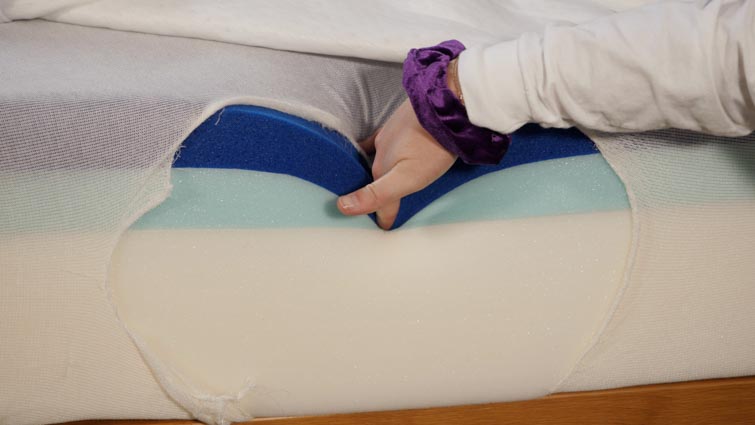
Support
A good mattress should evenly support your body in a variety of sleeping positions, helping to maintain a neutral spinal alignment. This is especially critical for couples of different weights who sleep together on a full or queen mattress. If the heavier sleeper rolls towards the middle and creates a downward slope, the lighter sleeper may end up rolling into their partner. This can create additional motion transfer and interfere with the support and feel.
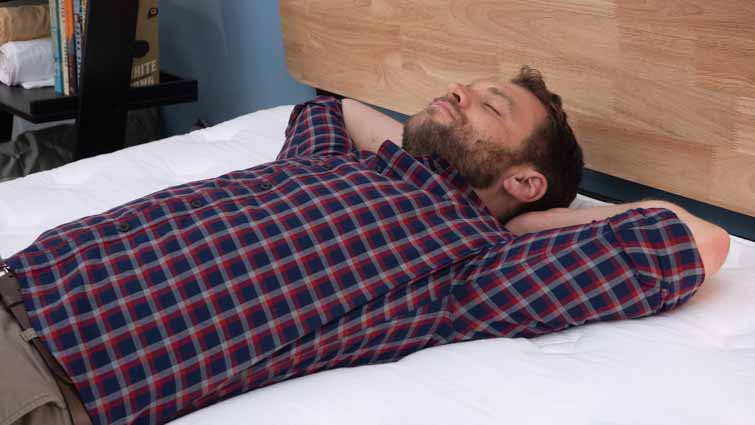
Sex
Whenever couples engage in amorous activities, bounce, response, overall support, edge support, and comfort can play a crucial role. The quicker a mattress is able to respond, the more natural and enjoyable the bounce and push-back feels in certain types of sex. In the past, only innerspring mattresses were able to provide couples with a high degree of bounce. Today, many all-foam or hybrid designs are able to achieve this, too. Make sure to take a look at our top picks of the best mattresses for sex to find the one that best fits your needs.
Edge Support
Beyond support for the purposes of sleeping, the mattress needs to be able to support the weight of two adults located in generally the same place. Selecting a mattress with robust materials and a good design along the edge of the bed, as well as in the center, will ensure that it’s capable of properly supporting the full weight, while still creating comfort, bounce, and response.
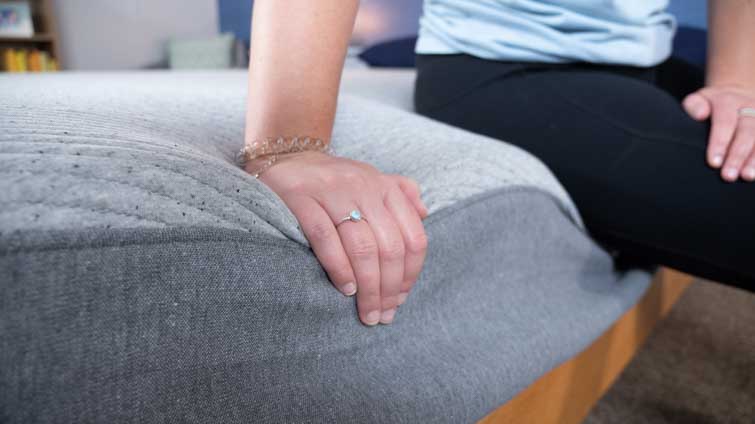
How We Test the Best Mattresses for Couples
For the majority of couples, there are four main qualities that they look for in a mattress: cooling, edge support, how good the mattress is for sex, and how well the mattress isolates movement. Let’s take a closer look at how we test these performance areas in our mattress lab.
Thermal Gun Test
When deciding if a mattress is good for cooling, it’s best to start with its construction (once again, hybrids and innersprings are your best bet). Or you can simply see how it feels to sleep on it at night during your mattress’s trial period. Does it feel airy, or are you waking up with night sweats?
Here in our mattress lab, we also like to test a mattress’s cooling capabilities with a device called a thermal gun. We just aim it at the mattress, and it uses thermal imaging to show us its temperature both before someone’s laid down on it and after they’ve laid on it for five minutes. If it heats up more than 15 degrees Fahrenheit, we consider the bed to have poor cooling capabilities. 10 to 15 degrees indicates decent cooling, 5 to 10 degrees indicates good cooling, and less than 5 degrees indicates excellent cooling.
Below is an image of the Saatva Rx before we’ve laid down on it.

Now let’s look at the mattress after we’ve laid on it for five minutes.

As you can see, the mattress heated up about 8 degrees, which indicates good cooling. When combining this test with the mattress’s build (dual layers of coils and foam with plenty of spaces in its construction), we think the Saatva Rx is an excellent mattress for cooling.
Responsiveness Test
The responsiveness test — which tells us how good a mattress is for sex — is a bit simpler. Our tester just lies down on the bed and sees how easy it is to roll around. If they’re able to move and switch positions with little difficulty, then chances are it’s a good mattress for sex. This is also tells us if the bed is one of the best mattresses for combination sleepers, who switch back and forth between different sleeping positions at night.
Edge Support Test
This is another simple one. To test a mattress’s edge support, we sit on the edge of the bed and see if we feel the layers buckling or collapsing beneath our weight. We then do the same while leaning over and tying our shoes. If the mattress stays sturdy with little give, then it probably has strong edge support.
Seismometer Test
Motion transfer refers to the movement that is detectable from one side of the bed to the other side. This is especially important for couples because it determines if your partner is going to be able to feel you tossing and turning at night.
In order to test motion isolation, our mattress testers drop a 10-pound steel ball from heights of four, eight, and 12 inches. The movement of the ball across the mattress is measured by a seismometer. The bigger the lines on the chart, the bigger the disturbance from one side of the mattress to the other. This will determine if your partner will feel every movement you make during the night, or if they’ll only feel the big movements, like getting in and out of bed in the morning.
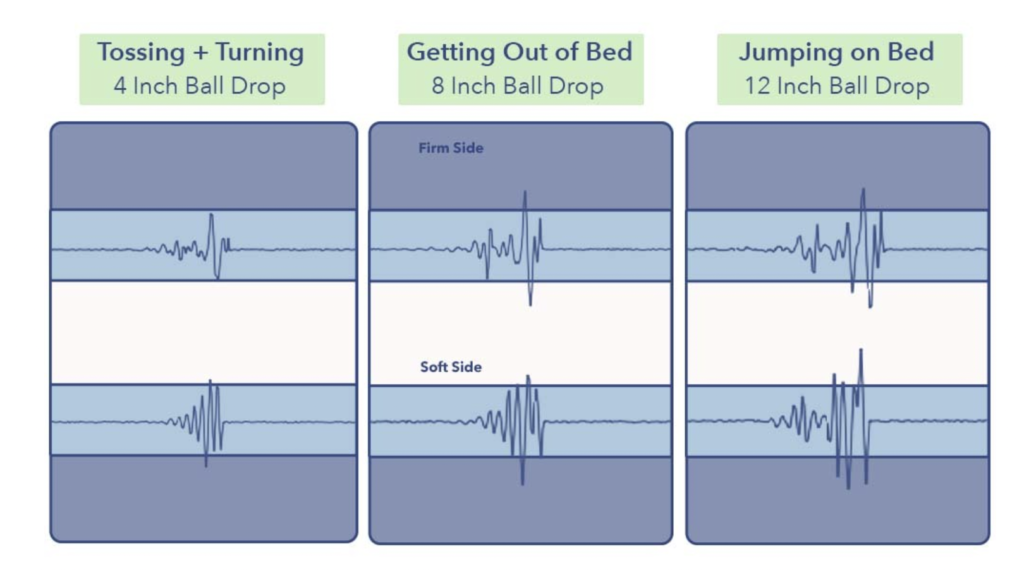
As you can see, the lines in this chart are relatively short, meaning less motion is getting transferred across the bed. For the majority of the mattresses on our list — like the Layla above — these lines are going to very short because most couples don’t want a mattress that jostles them whenever their partner moves. However, for other mattresses on the list — like the Birch Luxe — the lines on the chart are slightly higher, so couples are more likely to feel the movements of their partner throughout the night.
The motion transfer of a certain mattress mostly depends on the material that the mattress is made out of. Memory foam mattresses usually have a lower motion transfer score because the dense foam keeps the mattress stable when movement occurs. On the other hand, innerspring mattresses typically have a higher motion transfer score because they are bouncier and more responsive.
Motion transfer is not the end-all-be-all for buying a mattress as a couple. While an innerspring mattress has a higher motion transfer rate, it is also a better mattress for sex because of its responsiveness. While a memory foam mattress limits movements from couples, it could create a hotter atmosphere in the bed because the foams trap body heat. That is why Sleepopolis looks at all four main qualities that couples look for in a mattress and combine those scores together to see which mattress couples will be happiest in, depending on their preferences.
How We Chose These Mattresses
Our team of Certified Sleep Science Coaches has reviewed more than 300 products in our mattress lab, running each one through tests such as pressure-mapping and measuring motion transfer with a seismometer. From there, we give every bed an overall score based on materials, comfort, support, cooling, and edge support. We also factor in brand performance with categories such as value and warranty.
All of these categories become doubly important when deciding on the Best Mattresses for Couples, as there are two people sleeping on a mattress instead of just one. That’s why we put considerable attention on support, as there needs to be enough of it here to accommodate two bodies. All 10 mattresses here scored at least a 4 out of 5 on support.
FAQs
What type of mattress is good for couples?
You may have noticed that most of the mattresses on this list are hybrid models. While it’s entirely possible to find an all-foam model that works for couples (such as the Nolah), the weight of two bodies is going to need more support than many memory foam mattresses offer. So we recommend that couples start with hybrids when mattress-shopping.
Is memory foam good for two people?
While hybrid mattresses or innerspring mattresses tend to offer more support for couples, there are some memory foam beds out there that can work as well. One benefit the material has for couples is that it cuts down on motion transfer, so if you sleep with a partner, you’re less likely to feel each other’s movements at night.
What is edge support?
Edge support refers to how strong the perimeter of your mattress is. If a bed has good edge support, it means you can sleep near the edge of the mattress and still feel supported. Edge support is especially important when finding the best mattress for couples, as it gives them plenty of room to spread out.
What is the best mattress for intimacy?
The best mattress for sex is going to be one that’s responsive and allows you to easily move around and change positions. Hybrid and innerspring mattresses with lots of coils and bounce are usually best for this. We think the Saatva is an especially good choice due to its double layer of springs.
Best Mattress for Couples: Details and Pricing
| Mattress | Best For | Price (Queen) | Coupon | Review |
|---|---|---|---|---|
| Helix Dusk Luxe | Overall | $2,373 | Helix Coupon | Read Our Review |
| Emma Hybrid Comfort | Hybrid | $1,199 | Emma Coupon | Read Our Review |
| Saatva | Sex | $1,995 | Saatva Coupon | Read Our Review |
| WinkBed Plus | Heavy Couples | $1,999 | WinkBed Coupon | Read Our Review |
| Nolah | Side Sleeping | $1,449 | Nolah Coupon | Read Our Review |
| Leesa Sapira Chill | Back Sleepers | $2,159 | Leesa Coupon | Read Our Review |
| Brooklyn Bedding Sedona | Pressure Relief | $2,399 | Brooklyn Bedding Coupon | Read Our Review |
| Titan Plus by Brooklyn Bedding | Stomach Sleepers | $1,249 | Brooklyn Bedding Coupon | Read Our Review |
| Loom & Leaf by Saatva | Luxury | $2,395 | Saatva Coupon | Read Our Review |
| Birch Luxe by Helix | Cooling | $3,248 | Helix Coupon | Read Our Review |


